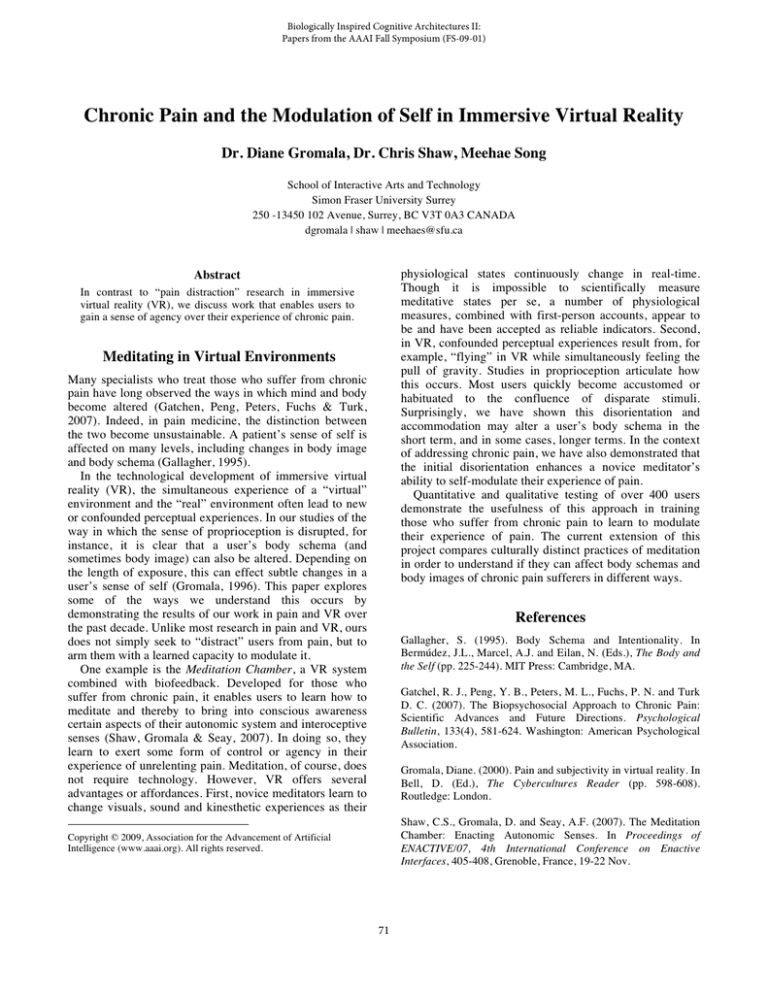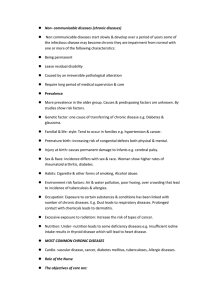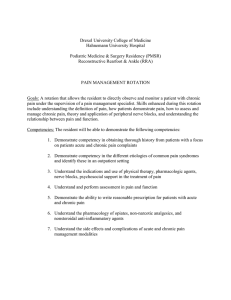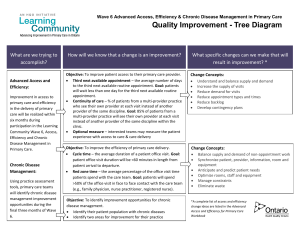
Biologically Inspired Cognitive Architectures II:
Papers from the AAAI Fall Symposium (FS-09-01)
Chronic Pain and the Modulation of Self in Immersive Virtual Reality
Dr. Diane Gromala, Dr. Chris Shaw, Meehae Song
School of Interactive Arts and Technology
Simon Fraser University Surrey
250 -13450 102 Avenue, Surrey, BC V3T 0A3 CANADA
dgromala | shaw | meehaes@sfu.ca
physiological states continuously change in real-time.
Though it is impossible to scientifically measure
meditative states per se, a number of physiological
measures, combined with first-person accounts, appear to
be and have been accepted as reliable indicators. Second,
in VR, confounded perceptual experiences result from, for
example, “flying” in VR while simultaneously feeling the
pull of gravity. Studies in proprioception articulate how
this occurs. Most users quickly become accustomed or
habituated to the confluence of disparate stimuli.
Surprisingly, we have shown this disorientation and
accommodation may alter a user’s body schema in the
short term, and in some cases, longer terms. In the context
of addressing chronic pain, we have also demonstrated that
the initial disorientation enhances a novice meditator’s
ability to self-modulate their experience of pain.
Quantitative and qualitative testing of over 400 users
demonstrate the usefulness of this approach in training
those who suffer from chronic pain to learn to modulate
their experience of pain. The current extension of this
project compares culturally distinct practices of meditation
in order to understand if they can affect body schemas and
body images of chronic pain sufferers in different ways.
Abstract
In contrast to “pain distraction” research in immersive
virtual reality (VR), we discuss work that enables users to
gain a sense of agency over their experience of chronic pain.
Meditating in Virtual Environments
Many specialists who treat those who suffer from chronic
pain have long observed the ways in which mind and body
become altered (Gatchen, Peng, Peters, Fuchs & Turk,
2007). Indeed, in pain medicine, the distinction between
the two become unsustainable. A patient’s sense of self is
affected on many levels, including changes in body image
and body schema (Gallagher, 1995).
In the technological development of immersive virtual
reality (VR), the simultaneous experience of a “virtual”
environment and the “real” environment often lead to new
or confounded perceptual experiences. In our studies of the
way in which the sense of proprioception is disrupted, for
instance, it is clear that a user’s body schema (and
sometimes body image) can also be altered. Depending on
the length of exposure, this can effect subtle changes in a
user’s sense of self (Gromala, 1996). This paper explores
some of the ways we understand this occurs by
demonstrating the results of our work in pain and VR over
the past decade. Unlike most research in pain and VR, ours
does not simply seek to “distract” users from pain, but to
arm them with a learned capacity to modulate it.
One example is the Meditation Chamber, a VR system
combined with biofeedback. Developed for those who
suffer from chronic pain, it enables users to learn how to
meditate and thereby to bring into conscious awareness
certain aspects of their autonomic system and interoceptive
senses (Shaw, Gromala & Seay, 2007). In doing so, they
learn to exert some form of control or agency in their
experience of unrelenting pain. Meditation, of course, does
not require technology. However, VR offers several
advantages or affordances. First, novice meditators learn to
change visuals, sound and kinesthetic experiences as their
References
Gallagher, S. (1995). Body Schema and Intentionality. In
Bermúdez, J.L., Marcel, A.J. and Eilan, N. (Eds.), The Body and
the Self (pp. 225-244). MIT Press: Cambridge, MA.
Gatchel, R. J., Peng, Y. B., Peters, M. L., Fuchs, P. N. and Turk
D. C. (2007). The Biopsychosocial Approach to Chronic Pain:
Scientific Advances and Future Directions. Psychological
Bulletin, 133(4), 581-624. Washington: American Psychological
Association.
Gromala, Diane. (2000). Pain and subjectivity in virtual reality. In
Bell, D. (Ed.), The Cybercultures Reader (pp. 598-608).
Routledge: London.
Shaw, C.S., Gromala, D. and Seay, A.F. (2007). The Meditation
Chamber: Enacting Autonomic Senses. In Proceedings of
ENACTIVE/07, 4th International Conference on Enactive
Interfaces, 405-408, Grenoble, France, 19-22 Nov.
Copyright © 2009, Association for the Advancement of Artificial
Intelligence (www.aaai.org). All rights reserved.
71








